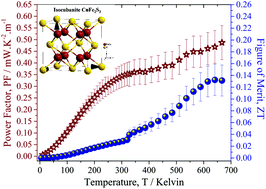Structural and thermoelectric properties of n-type isocubanite CuFe2S3
Abstract
An effective strategy to enhance thermoelectric performance consists of scattering phonons by point defects, such as the ones intrinsic to the n-type isocubanite CuFe2S3. In this structure, the TEM evidences a random distribution of vacancies, and copper and iron ions of the 4c and 4d sites naturally reduce the phonon lifetime. Furthermore, orthorhombic and cubic cubanite are usually found in their natural states intimately intergrown with other sulfides such as chalcopyrite (CuFeS2) and pyrrhotite (Fe7S8). We performed comprehensive studies of Rietveld analysis of X-ray diffraction, transmission electron microscopy, and thermoelectric transport measurements of the n-type isocubanite CuFe2S3, and we obtained a maximum ZT value of 0.14 at 700 K in this environmentally friendly compound. Our electronic structure calculations support the fact that chalcopyrite CuFeS2 is an antiferromagnetic insulator, together with a higher degree of covalency of sulfide compared to oxides. The weak temperature dependence of the resistivity points towards strong disorder in the 4c and 4d sites of the isocubanite.

- This article is part of the themed collection: In honour of Mercouri G. Kanatzidis for his contributions to Inorganic Chemistry for over 30 years


 Please wait while we load your content...
Please wait while we load your content...